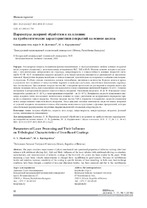| dc.contributor.author | Дьяченко, О. В. | ru |
| dc.contributor.author | Кардаполова, М. А. | ru |
| dc.coverage.spatial | Минск | ru |
| dc.date.accessioned | 2018-02-09T08:39:50Z | |
| dc.date.available | 2018-02-09T08:39:50Z | |
| dc.date.issued | 2018 | |
| dc.identifier.citation | Дьяченко, О. В. Параметры лазерной обработки и их влияние на трибологические характеристики покрытий на основе железа = Parameters of Laser Processing and Their Influence on Tribological Characteristics of Iron-Based Coatings / О. В. Дьяченко, М. А. Кардаполова // Наука и техника. – 2018. – № 1. - С. 56-63. | ru |
| dc.identifier.uri | https://rep.bntu.by/handle/data/37526 | |
| dc.description.abstract | Рассмотрены вопросы повышения физико-механических и эксплуатационных свойств клеевых покрытий после лазерного оплавления с дополнительным легированием В₄С, ТаВ и МоВ. Изучено влияние лазерного оплавления с дополнительным легированием на структуру, микротвердость и износостойкость клеевых покрытий системы Fe–Cr–B –Si. С увеличением скорости лазерного луча микроструктура изменяется от равновесной до квазиэвтектической. Присутствие боридов молибдена и тантала повысило чувствительность покрытия к особенностям лазерного переплава. В обоих случаях изменились условия теплообмена, увеличилось количество боридов железа и хрома, в результате чего молибден и тантал частично перешли в свободное состояние, способствуя измельчению структурных составляющих. При введении твердых частиц B₄C в покрытие происходит их растворение в матрице железа при нагреве лазерным лучом, при охлаждении они выделяются в виде отделенных включений боридов Fe и Cr. Лазерное оплавление и легирование повышают износостойкость покрытий. Увеличение нагрузки с 30 до 70 Н повышает износ покрытий в среднем на 15–26 %, а нелегированных покрытий – на 26–43 %. Повышение скорости оплавления и диаметра лазерного пятна не оказывает значительного влияния на износ, увеличение же коэффициента перекрытия приводит к снижению износа покрытия. Наличие твердых частиц ТаВ в покрытии и повышение скорости оплавления лучом лазера снижают износостойкость покрытия. Такая довольно сложная зависимость скорости износа покрытий от условий лазерного оплавления и износа обусловлена комплексом структурных и фазовых превращений, которые способствовали формированию вторичных твердых включений и повысили микротвердость. | ru |
| dc.language.iso | ru | ru |
| dc.publisher | БНТУ | ru |
| dc.subject | Лазерная обработка | ru |
| dc.subject | Скорость луча лазера | ru |
| dc.subject | Микротвердость | ru |
| dc.subject | Микроструктура | ru |
| dc.subject | Покрытие | ru |
| dc.subject | Фазовый состав | ru |
| dc.subject | Интенсивность изнашивания | ru |
| dc.subject | Laser processing | en |
| dc.subject | Laser beam Velocity | en |
| dc.subject | Microhardness | en |
| dc.subject | Microstructure | en |
| dc.subject | Coating | en |
| dc.subject | Phase composition | en |
| dc.subject | Wear intensity | en |
| dc.title | Параметры лазерной обработки и их влияние на трибологические характеристики покрытий на основе железа | ru |
| dc.title.alternative | Parameters of Laser Processing and Their Influence on Tribological Characteristics of Iron-Based Coatings | en |
| dc.type | Article | ru |
| dc.identifier.doi | 10.21122/2227-1031-2018-17-1-56-63 | |
| local.description.annotation | The paper considers improvement of physic-mechanical and operational properties of adhesive coatings after laser infusion with additional alloying В₄С, ТаВ and МоВ. Influence of the laser infusion with additional alloying on structure, microhardness and wear-resistance of adhesive coatings of the Fe–Cr–B –Si system has been studied in the paper. While increasing a laser beam velocity microstructure is changed from equilibrium to quasi-eutectic. Presence of molybdenum boride and tantalum increases sensitivity of the coating to specific features of laser remelting. In both cases heat exchange conditions have been changed, a number of iron and chromium borides has been increased and due to this molybdenum and tantalum have been partially passing to free state that contributes to a disintegration of structural components. While introducing solid particles B₄C into a coating they are dissolved in an iron matrix while being heated by a laser beam and under cooling they are isolated in the form of separated Fe an Cr boride inclusions. Laser infusion and alloying increase coating wear-resistance. Load increase from 30 to 70 Н improves coating wear resistance averagely by 15–26 % and wear resistance of non-alloyed coatings is improved by 26–43 %. An increase of melting rate and laser spot diameter does not exert significant influence on wear but an increase in overlapping coefficient leads to reduction of coating wear. Presence of solid particles in a coating and an increase in rate of melting by laser beam reduce coating wear resistance. Such rather complicated dependence of coating wear rate on conditions of laser melting and wearing process is due to a complex of structural and phase transformations which have contributed to formation of secondary solid inclusions and increased microhardness. | en |

